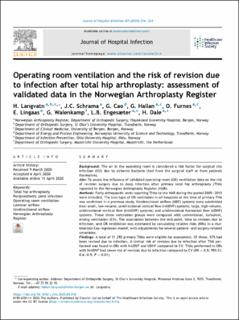Operating room ventilation and the risk of revision due to infection after total hip arthroplasty: assessment of validated data in the Norwegian Arthroplasty Register
Langvatn, Håkon; Schrama, Johannes Cornelis; Cao, Guangyu; Hallan, Geir; Furnes, Ove; Lingass, Egil; Walenkamp, Geert; Engesæter, Lars Birger; Dale, Håvard
Journal article, Peer reviewed
Published version

View/
Date
2020Metadata
Show full item recordCollections
- Department of Clinical Medicine [2086]
- Registrations from Cristin [10237]
Original version
Journal of Hospital Infection. 2020, 105 (2), 216-224 https://doi.org/10.1016/j.jhin.2020.04.010Abstract
Background
The air in the operating room is considered a risk factor for surgical site infection (SSI) due to airborne bacteria shed from the surgical staff or from patients themselves.
Aim
To assess the influence of validated operating room (OR) ventilation data on the risk of revision surgery due to deep infection after primary total hip arthroplasty (THA) reported to the Norwegian Arthroplasty Register (NAR).
Methods
Forty orthopaedic units reporting THAs to the NAR during the period 2005–2015 were included. The true type of OR ventilation in all hospitals at the time of primary THA was confirmed in a previous study. Unidirectional airflow (UDF) systems were subdivided into: small, low-volume, unidirectional vertical flow (lvUDVF) systems; large, high-volume, unidirectional vertical flow (hvUDVF) systems; and unidirectional horizontal flow (UDHF) systems. These three ventilation groups were compared with conventional, turbulent, mixing ventilation (CV). The association between the end-point, time to revision due to infection, and OR ventilation was estimated by calculating relative risks (RRs) in a multivariate Cox regression model, with adjustments for several patient- and surgery-related covariates.
Findings
A total of 51,292 primary THAs were eligible for assessment. Of these, 575 had been revised due to infection. A similar risk of revision due to infection after THA performed was found in ORs with lvUDVF and UDHF compared to CV. THAs performed in ORs with hvUDVF had lower risk of revision due to infection compared to CV (RR = 0.8; 95% CI: 0.6–0.9; P = 0.01).
Conclusion
THAs performed in ORs with hvUDVF systems had lower risk of revision due to infection compared to THAs performed in ORs with CV systems. The perception that all UDF systems are similar and possibly harmful seems erroneous.
